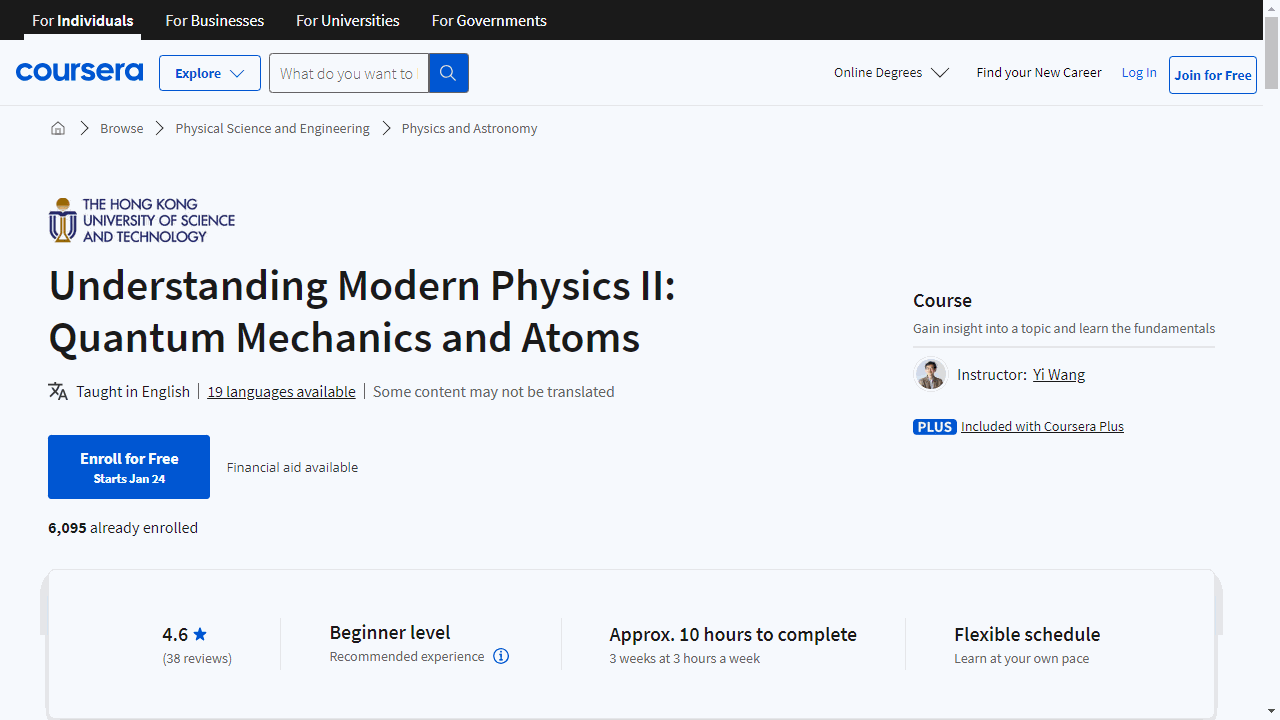Finding the right quantum computing course on Coursera can be a real challenge, especially with so many options available.
You want something that covers the fundamentals, dives into advanced topics, and is taught by experts.
You also want to make sure it fits your learning style and goals.
We’ve analyzed the best quantum computing courses on Coursera to bring you our top recommendations.
For the best overall quantum computing course, we recommend Introduction to Quantum Information by the Korea Advanced Institute of Science and Technology (KAIST).
This comprehensive course starts with the basics of quantum theory and progresses to advanced concepts like qubit manipulation and quantum teleportation.
It’s highly rated for its clear explanations, practical examples, and engaging approach to this fascinating field.
If you’re looking for something else, don’t worry!
We have a selection of other top-rated courses on Coursera that focus on various aspects of quantum computing.
Keep reading for more recommendations, including courses on quantum mechanics, quantum algorithms, and the practical applications of this revolutionary technology.
Introduction to Quantum Information
Provider: Korea Advanced Institute of Science and Technology(KAIST)
This course builds your understanding from the ground up, starting with the basics of quantum theory and progressing to advanced concepts.
You’ll begin by exploring simple quantum experiments that lay the groundwork for quantum principles.
Then, you’ll delve into qubits, the core of quantum information, learning about their unique state transformations and probabilities.
This includes practical knowledge of mixed states and the Bloch sphere, a tool for visualizing the quantum states of qubits.
The course then takes you through the dynamics of qubits and the challenges of quantum state discrimination.
You’ll also encounter important limitations in quantum computing through no-go theorems.
A key highlight is the section on two-qubit entanglement, where you’ll understand how qubits can be interconnected in ways impossible for traditional computers.
This leads to hands-on lessons in quantum teleportation, a fascinating technique that’s critical to quantum information processing.
As you progress, you’ll tackle the Deutsch Problem and the Deutsch algorithm, foundational elements that showcase the power of quantum computing.
You’ll also gain expertise in phase estimation, a vital component of quantum algorithms.
The curriculum includes an in-depth look at quantum channels, exploring various models like the Kraus representation and CPTP maps, and explaining their significance in quantum computing.
Towards the end, you’ll appreciate why entangled states are not just a theoretical curiosity but a practical resource.
You’ll learn techniques for manipulating entanglement, even in complex scenarios involving multipartite states and mixed state entanglement.
Led by KAIST’s experts, this course will equip you with a robust understanding of quantum information.
By the time you finish, you’ll have a comprehensive grasp of the subject, ready to tackle the future of computing.
Understanding Modern Physics II: Quantum Mechanics and Atoms
Provider: The Hong Kong University of Science and Technology
This course zeroes in on quantum mechanics, the backbone of quantum computing.
You’ll start by unraveling the dual nature of light, a fundamental concept in physics, through the photoelectric effect and the single photon double slit experiment.
This sets the stage for understanding wave-particle duality, a cornerstone of quantum theory.
Wave functions come next, offering you the tools to predict particle behavior.
You’ll tackle momentum and its quantum implications, contrasting it with classical physics to appreciate the uniqueness of the quantum realm.
The course demystifies measurements in quantum mechanics, introducing you to the Uncertainty Principle.
This principle is not just a theoretical curiosity; it’s essential for the precision required in quantum computing.
Dive into the Schrodinger equation, the pivotal formula that describes how quantum states evolve over time.
You’ll explore concepts like potential wells and tunneling, directly applicable to quantum computing tasks such as qubit manipulation.
Understanding identical particles is crucial, and you’ll distinguish between bosons and fermions, learning how their behavior underpins quantum statistics.
The course doesn’t just teach; it shows how these theories were developed.
You’ll trace the journey from kinetic gas theory to atomic spectroscopy, gaining insights into the sub-atomic structure and the periodic table’s deeper meaning.
Finally, you’ll delve into quantum information theory with the Stern-Gerlach experiment, which introduces spin and qubits—the basic units of quantum information.
The course tackles complex ideas like the EPR paradox and Bell inequality, challenging classical assumptions and paving the way for quantum computing breakthroughs.
By the end of this course, you’ll have a robust understanding of quantum mechanics, preparing you to engage with quantum computing’s complexities.
Also check our posts on:


